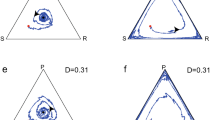Abstract
We observe that a symmetric two-player zero-sum game has a pure strategy equilibrium if and only if it is not a generalized rock-paper-scissors matrix. Moreover, we show that every finite symmetric quasiconcave two-player zero-sum game has a pure equilibrium. Further sufficient conditions for existence are provided. Our findings extend to general two-player zero-sum games using the symmetrization of zero-sum games due to von Neumann. We point out that the class of symmetric two-player zero-sum games coincides with the class of relative payoff games associated with symmetric two-player games. This allows us to derive results on the existence of finite population evolutionary stable strategies.
Similar content being viewed by others
References
Alós-Ferrer C, Ania AB (2005) The evolutionary stability of perfectly competitive behavior. Econ Theory 26: 497–516
Ania A (2008) Evolutionary stability and Nash equilibrium in finite populations, with an application to price competition. J Econ Behav Organ 65: 472–488
Brânzei R, Mallozzi L, Tijs S (2003) Supermodular games and potential games. J Math Econ 39: 39–49
Brown GW, von Neumann J (1950) Solutions of games by differential equations. In: Kuhn HW, Tucker AW (eds) Contributions to the theory of games (Annals of Mathematics Studies no. 24). Princeton University Press, Princeton, pp 81–87
Duersch P, Oechssler J, Schipper BC (2011) Unbeatable imitation mimeo. University of Heidelberg and the University of California, Davis
Gale D, Kuhn HW, Tucker AW (1950) On symmetric games. In: Kuhn HW, Tucker AW (eds) Contributions to the theory of games. Annals of Mathematics Studies, Princeton University Press, Princeton, pp 81–87
Hehenkamp B, Leininger W, Possajennikov A (2004) Evolutionary equilibrium in Tullock contests: spite and overdissipation. Eur J Polit Econ 20: 1045–1057
Hehenkamp B, Possajennikov A, Guse T (2010) On the equivalence of Nash and evolutionary equilibrium in finite populations. J Econ Behav Organ 73: 254–258
Kaplansky I (1945) A contribution to von Neumann’s theory of games. Ann Math 46: 474–479
Leininger W (2006) Fending off one means fending off all: evolutionary stability in quasi-submodular games. Econ Theory 29: 713–719
Matros A, Temzelides T, Duffy J (2009) Competitive behavior in market games: evidence and theory, mimeo. University of Pittsburgh, Pittsburgh
Monderer D, Shapley LS (1996) Potential games. Games Econ Behav 14: 124–143
Nash J (1951) Non-cooperative games. Ann Math 54: 286–295
Nydegger RV, Owen G (1974) Two-person bargaining: an experimental test of the Nash axioms. Int J Game Theory 3: 239–249
Possajennikov A (2003) Evolutionary foundation of aggregative-taking behavior. Econ Theory 21: 921–928
Radzik T (1991) Saddle point theorems. Int J Game Theory 20: 23–32
Roth AE, Malouf MWK (1979) Game-theoretic models and the role of information in bargaining. Psychol Rev 86: 574–594
Schaffer ME (1988) Evolutionary stable strategies for a finite population and a variable contest size. J Theor Biol 132: 469–478
Schaffer ME (1989) Are profit-maximizers the best survivors?. J Econ Behav Organ 12: 29–45
Schipper BC (2003) Submodularity and the evolution of Walrasian behavior. Int J Game Theory 32: 471–477
Shapley LS (1964) Some topics in two-person games. In: Dresher M, Shapley LS, Tucker AW (eds) Advances in game theory (Annals of Mathematical Studies no. 52). Princeton University, Princeton, pp 1–28
Tanaka Y (2000) A finite population ESS and a long run equilibrium in an n-players coordination game. Math Soc Sci 39: 195–206
Topkis DM (1998) Supermodularity and complementarity. Princeton University Press, Princeton
Vega-Redondo F (1997) The evolution of Walrasian behavior. Econometrica 65: 375–384
von Neumann J (1928) Zur Theorie der Gesellschaftsspiele. Mathematische Annalen 100: 295–320
Author information
Authors and Affiliations
Corresponding author
Rights and permissions
About this article
Cite this article
Duersch, P., Oechssler, J. & Schipper, B.C. Pure strategy equilibria in symmetric two-player zero-sum games. Int J Game Theory 41, 553–564 (2012). https://doi.org/10.1007/s00182-011-0302-x
Accepted:
Published:
Issue Date:
DOI: https://doi.org/10.1007/s00182-011-0302-x
Keywords
- Symmetric two-player games
- Zero-sum games
- Rock-paper-scissors
- Single-peakedness
- Quasiconcavity
- Finite population evolutionary stable strategy
- Saddle point
- Exact potential games




